Struggling to light your wood burner? Even when using kiln dried logs there are several factors that can hinder how effectively your fire will combust.
This blog puts the spotlight on the most common pitfalls when trying to light a fire inside a wood burning stove – and what you can do to successfully start a fire and keep it going. So with any luck, these top tips will have your fire roaring away in no time!
1) Are the logs Ready To Burn?
The problem: If your logs ARE NOT kiln dried and Woodsure Ready To Burn certified, there’s a strong possibility the moisture content at the heart of the log is above 20%. After all, you can’t burn water, and if you try, the chances are your stove will be filled with ugly black smoke. And worse still, creosote will start to build up in your chimney, and greatly increase the risk of a chimney fire.
For example: A 2kg unseasoned log with 50% moisture is half water – that’s 1 litre of water to burn off. Burning wet wood means much of the heat generated is used to burn off excess water – resulting in less warmth for your space and more harmful particulates being released into the atmosphere.
Burning wet wood doesn’t just harm the environment and your stove, but it puts a big hole in your purse too! Wet wood emits more harmful emissions and far less heat – so you end up burning more wood, creating more pollution, and spending even more money.
Wet wood. False economy.
No matter how efficient your stove is – it can only ever be as good as the wood you put in it.
Solution: Only burn logs that are kiln dried to a moisture content of at least 20% and below. That way, you only pay for wood, not water!
Firewood is only ready for use and ready to burn if the moisture content at the heart of the log is 20% or less. The best way to ensure your logs are burn ready is to buy logs that are Woodsure Ready To Burn certified.
The Woodsure Ready To Burn scheme the UK’s only wood fuel quality assurance scheme and helps homeowners look after their stoves and improve air quality.
2) Is your chimney suffering from Cold Chimney Syndrome?
The problem: A build up of cold air trapped inside your chimney or flue is a sign your chimney is suffering from Cold Chimney Syndrome. But why does it happen?
When too much cool air pushes down inside your wood burning stove it means room temperature air is prevented from being drawn into the fire (even if your damper is fully open). You’ll know if your fire is affected by Cold Chimney Syndrome if it goes out very soon after it’s started.
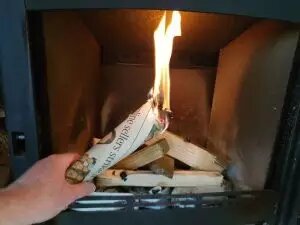 Solution: Warm your stove and chimney before starting your fire by following these steps:
Solution: Warm your stove and chimney before starting your fire by following these steps:
- Roll up piece of newspaper and light one end
- Still holding the paper with one hand, place the ignited end of the paper inside and at the top of your appliance or fireplace for a short while.
- Once you can see the smoke from the newspaper rising up the chimney your wood burning stove is ready for fire lighting and the chimney is drawing on the appliance effectively.
And that’s it! As long as there are no other factors affecting the lighting of your fire you should find it so much easier, and quicker, to get a fire started.
 Pro tip: Steve from Stephen Morris Master Chimney Sweep Ltd says:
Pro tip: Steve from Stephen Morris Master Chimney Sweep Ltd says:
“Keep your stove door slightly ajar when it’s not being used.
“That way, a small amount of room temperature air will draw up the flue and help it to stay warm and aid combustion when lighting.”
3) Is your fire hot enough?
The problem: If your fire is smoldering soon after starting there’s a chance the wood isn’t lighting properly – and could be emitting a lot of smoke. The most likely reason is the appliance isn’t warm enough to light a fire and optimum wood burning temperatures haven’t yet been fulfilled.
Wood burning is most efficient when temperatures of 125C-300C (260F and 575F) are reached.
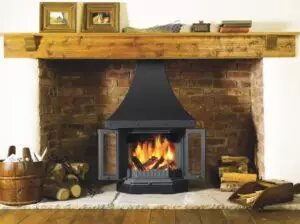 Solution: The best way to start a fire and keep it going is to build smaller fires at the start and then build it up slowly when the logs begin to take light. Doing this will allow enough time for your wood burning appliance to reach optimum wood burning temperatures.
Solution: The best way to start a fire and keep it going is to build smaller fires at the start and then build it up slowly when the logs begin to take light. Doing this will allow enough time for your wood burning appliance to reach optimum wood burning temperatures.
Smaller, hotter fires are far more efficient at the beginning than large fires that haven’t yet got enough energy in them to properly combust.
Or try the top down fire lighting method in point 7.
Pro tip: Buy a stove thermometer to indicate when optimum burn temperatures have been achieved. They don’t cost the earth. Bonus!
 4) Do the logs feel cold?
4) Do the logs feel cold?
The problem: You’ve just been out to the log store and it’s a chilly day. You’ve brought some logs inside to get a quick fire started…but the fire is struggling to ignite!
Solution: Logs kept at room temperature will always combust far more easily than logs that have been stored in cold outdoor conditions. Keep some logs inside your home (but not directly next to the appliance) so you have room temperature firewood that is ready for use and ready to burn.
5) Check the damper is fully open
The problem: A closed or partially open fireplace damper can result in smoke being emitted into your room instead of safely up the chimney.
Solution: If your fireplace has a damper make sure it’s fully open before starting your fire. The chimney will produce the maximum draw on the fireplace when the damper is fully open – so the air in your room will flow nicely into your appliance.
6) Are you using too many logs?
The problem: Building a fire too quickly with too many logs can create excessive smoke as there isn’t enough energy for all the wood to alight.
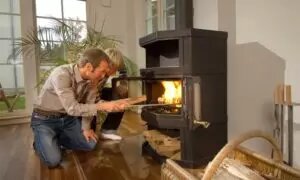 Solution: When it comes to lighting a fire less is certainly more. Adding just one or two logs at a time will allow the logs to feed off and transfer heat between each other as they burn.
Solution: When it comes to lighting a fire less is certainly more. Adding just one or two logs at a time will allow the logs to feed off and transfer heat between each other as they burn.
How to get a fire started:
- Grab a handful of kindling and place inside your wood burning appliance.
- Get 1-2 natural firelighters and nestle between your kindling, light the firelighters with a match or lighter, and wait a few moments for the kindling to catch fire. Go to step 4 if you’re using kiln dried softwood.
- If you’ve not got any kiln dried softwood logs to hand just use more kindling to get plenty of energy in your fire and follow step 5.
- Use your kiln dried softwood logs to keep building your fire up. Start with smaller logs but be careful not to add more logs too soon so you don’t smother your kindling.
- Once your roaring fire is starting to settle a little, add 1-2 kiln dried hardwood logs so your fire will last a good while before you need to add more or let it burn out.
7) Try the top down fire lighting method
Want to light your wood burning stove like a pro? The top down fire lighting method (otherwise known as an upside down fire) is all the rage with stove manufacturers, stove fitters and any chimney sweep worth their salt (or soot!).
Not only does the top down fire lighting method make the fire less smokey when lighting but research shows it maximizes fuel efficiency too.
 Here’s how to light a top down fire:
Here’s how to light a top down fire:
- Place the largest kiln dried logs across the bottom of your stove.
- Place a second layer of smaller kiln dried logs on top but in the opposite direction.
- Then place a third layer of even smaller kiln dried logs across the layer beneath.
- Spread a fine layer of kindling across the top.
- Grab 2-3 natural firelighters, set alight, and nestle between your kindling so it will catch fire.
- Make sure your stove damper is open, or your combustion fan is high, to increase the draw of air into your stove.
- Close the stove door.
- As the firelighters burn the kindling will ignite – and the fire will begin to slowly descend through to the logs beneath and allow them to combust.
- Sit back and enjoy the comfort of your top down fire! You just lit it like a pro!
8) Have you swept your chimney recently?
The problem: If your chimney hasn’t been cleaned or swept in the last 12 months there might not be enough draw on the fireplace from the chimney to keep your fire going. There’s also a big risk that creosote is building up in the flue – which greatly increases the risk of a chimney fire.
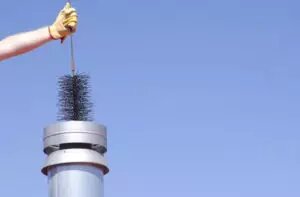 Solution: HETAS recommends that a chimney is professionally swept and cleaned at least once a year (depending on the appliance and the type of fuel being used). The HETAS Find a Chimney Sweep search makes it easy to find your nearest local HETAS Approved Chimney Sweep. Just enter your postcode in the search box to find a HETAS approved chimney sweep near you.
Solution: HETAS recommends that a chimney is professionally swept and cleaned at least once a year (depending on the appliance and the type of fuel being used). The HETAS Find a Chimney Sweep search makes it easy to find your nearest local HETAS Approved Chimney Sweep. Just enter your postcode in the search box to find a HETAS approved chimney sweep near you.
We recommend: Stephen Morris Master Chimney Sweep Ltd – our ‘go to’ HETAS approved chimney sweep.
You can’t start a fire without a spark!
So fingers crossed, when you put these fire lighting solutions into practice, it’ll be FLAME ON for that cosy evening in by the fire after all!
*Just so you’re aware, this guidance shouldn’t replace the advice provided by your stove manufacturer or stove fitter. Always ensure your fire goes out before going to bed or leaving the house Avoid slumbering an appliance unless it’s been specifically tested as safe to do so.
|
- Read more of our blogs to get handy wood burning tips and keep on top of industry news.
- To see our range of Ready To Burn-certified logs and arrange a FREE DELIVERY (to the home side – NOT the curb side) take a look around our SHOP
Follow us!
Be the first to hear about our offers, wood burning advice and so much more!
Burn it. Love it. Tag it! #TheLogPeopleSnaps
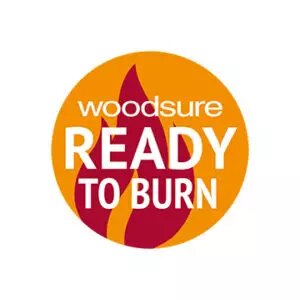
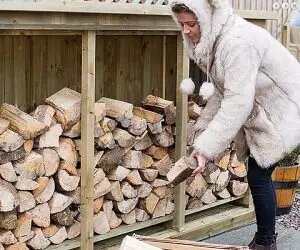 4) Do the logs feel cold?
4) Do the logs feel cold?
 Here’s how to light a top down fire:
Here’s how to light a top down fire:
A great post and very useful tips. Thanks a lot for sharing this. Good work.